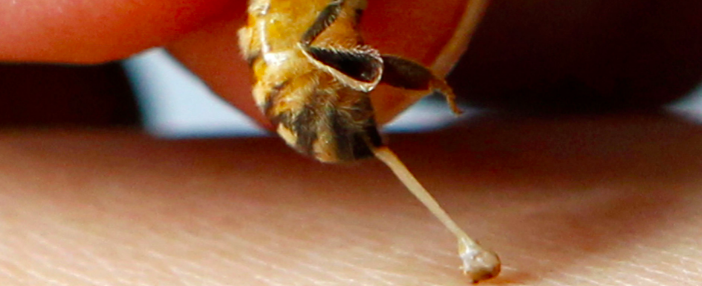
Prevention
These insects sting for self-defense so if a wasp bothers you, avoid any sudden movement. If it lands on you, let it go on its own or gently push it away. If you’ve disturbed a nest, get away as quickly as possible.
In nature
- Keep sugary foods and meat in closed containers: the adult wasp looks for sugar to feed itself and it must bring protein to the larvae of the colony, the latter being carnivorous.
- Watch your food carefully, especially that of children. Before taking a bite or sip of juice or sweet liquor, make sure there is no wasp in it. Even in the mouth or throat, it could sting.
- Prefer long clothes. Tie up your hair. Wear a mosquito net hat if necessary.
- Avoid walking barefoot: some nests are underground.
- If a wasp enters the car, open the windows. It will come out on its own.
In the House
- Use garbage cans with lids.
- Do not leave any table waste lying around.
- Make sure all the windows in your house have screens.
Wasps or bumblebees nest
Have you spotted a nest of wasps or bumblebees ? Do not approach it, do not disturb it, rather keep an eye out to find out what is going on there.
Early in the spring , the young queen leaves her shelter and goes in search of a suitable site for her colony. Once the site is found, she builds the nest and begins to lay eggs. The nest, at this stage, is small, and can be removed quite easily.
During the summer , the population increases … and so does the comings and goings: as the larvae become workers, they emerge from the nest in order to find food for the new larvae. Eliminating the nest is now difficult and riskier.
If you spot a nest of wasps or bumblebees in the fall , rest assured, as this season marks the end of their life cycle, except for the young queens, which will perpetuate the species. But no doubt they will already have gone to take refuge in a winter shelter.
Warning!
Removing a nest yourself, blocking the entrance or using commercial wasp traps always involves risks.
Follow the manufacturer’s instructions carefully. Better yet, leave this task to extermination professionals. If the nest is on public or private land, report its presence to the municipality or the owner.
What to do in case of a bite
Examine the stung area
In most people, there will be redness, pain, warmth, and swelling around the site of the bite. This reaction is normal, and although it may seem very worrying, it will go away within hours or days.
Just apply cold compresses and take pain control medicine (acetaminophen). However, if the local reactions are very widespread or accompanied by fever or local infection, consult a doctor.
When to worry
The reaction becomes abnormal and worrisome when it occurs elsewhere than at the site of the bite. Signs of a serious reaction are: swelling of the face, generalized hives (redness), change in voice, difficulty swallowing or breathing, asthma attack, weakness, persistent vomiting, loss of consciousness or shock . Such a reaction can occur just a few minutes after the bite and be life threatening. If one or more of these symptoms are present, act quickly: administer EpiPen® (available from pharmacies without a prescription), take an antihistamine (Benadryl®) and go to the nearest emergency department. If necessary, call 911.
People who have had an allergic reaction to a wasp, bee or bumblebee sting have a 60% risk of having another similar one or worse if stung again by the same species. Have you ever observed one or more signs of allergy following an insect bite? Talk to your doctor.
In addition, there is a desensitization treatment with bee or wasp venom, 97% effective. If you have ever experienced strong reactions to an insect bite, see an allergist.